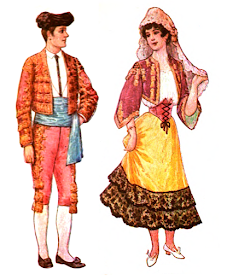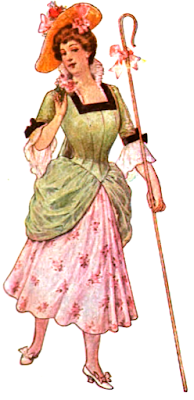 |
| Melody by Harrison Fisher (1907) |
Because costumes are such an important part of Mardi Gras celebrations, I am featuring fancy dress costumes which appeared in The Delineator in January 1903. The Butterick patterns to make these costumes were sold for 25 to 50 cents each. I have included the descriptions along with the pictures, which detail the features of the costumes, as well as accessories to be worn.
Fancy Dress Costumes
(Adapted From The Delineator, January 1903)
There is a keen pleasure aroused by the anticipation of attending a fancy ball, and no small part of it is due to the planning of what shall be worn. As in selecting other costumes, individual becomingness should here be carefully studied: The brunette will select some character especially adapted to her, while the woman whose hair is light and complexion fair will choose the more dainty effects. An important detail of fancy dress is the arrangement of the hair, which should be in keeping with the character assumed, although in some instances a picturesque head-dress is worn. Effect is the chief consideration in carnival attire, and not so much the quality of the material; it is possible to achieve artistic results in the use of inexpensive fabrics, though, of course, rich brocades, Pompadour silks and velvets and beautiful Oriental stuffs will yield most artistic effects.
Toreador--This costume consists of a white shirt, dull-red breeches trimmed with gold braid, with jacket to match, light-brown stockings and dark-brown shoes, and a sash of blue silk worn about the waist. A black tie and cap are essential features of this costume, the pattern for which costs 30 cents.
Spanish Costume--A fitting companion to the costume described above is this gay-colored mode to be worn by a brunette. The short skirt is of yellow satin, trimmed around the bottom with black lace flounces; the low bodice is made of soft white silk, and the senorita jacket of deep red velvet is elaborately decorated with gold braid and fringe ornaments; the pointed girdle of velvet to match the jacket is laced with black velvet ribbon. The lace mantilla fastened at each side with red or yellow roses lends a characteristic touch. The price of the pattern is 30 cents.
Martha Washington
This costume will lend dignity to the wearer, who to complete the picture should powder her hair. A rich brocade was used to make the gown; the bodice is cut in V outline in front and finished with a fichu of white mull, crossed at the bust and brought around to the centre of the back at the waist-line. The skirt opens in front over a panel effect, and a train is worn. A cap of mull is added. Price of pattern, 40 cents.
Italian Skirt Dancer--Picturesque in the extreme is this costume, which is sometimes called the Taglioni dress. China silk, cashmere or other soft materials are suitable to make the gown, with spangled velvet for the boleros and short-waisted girdle. The skirt is in two sections, the upper one opening in the front over the under-skirt, and the ends are left free to be gracefully handled in the dance. The price of the pattern is 30 cents.
Uncle Sam-- This patriotic costume consists of trousers made of red-and-white striped material--linen or the like--a very long swallow-tail coat made of a blue fabric and a plain white or striped vest. A high collar having exaggerated wings in front and bow tie are worn, also a tall hat with a band of plain blue or red or white with stars over it. The pattern costs 30 cents.
Watteau or Shepherdess Costume
This picturesque dress consists of a low, square-cut bodice, pointed in front, elbow sleeves finished with deep frills, and a short, full skirt with panier drapery. Pale-green satin was associated with Pompadour satin in this instance, and black velvet was used to trim. White silk stockings and slippers, and a large picture hat are worn with this costume, the pattern for which costs thirty cents.
Portia or College Gown-- The simple elegance of this robe of black satin or silk will appeal to dignified tastes. The robe entirely conceals the under-dress, and the large loose sleeves add to the stateliness. A mortar-board cap is worn. The price of the pattern is 50 cents.
Rough Rider Costume--This military or "Rough Rider" costume may be made of tan-colored denim trimmed with either red or yellow denim or of linen in the same colors, and brass buttons add to its military air. Leggings to match are worn, also a "Rough Rider" hat. The pattern price is 25 cents.
Bat Costume--Soft black silk, or even veiling or gauze over a black foundation are appropriate materials to use. The bodice is low-necked and short-sleeved with puffs giving becoming breadth at the shoulders. Long Black gloves are worn to cover the arm and hand. The mantle is of black satin, made double and whaleboned to retain the proper shape. Pattern price 30 cents.
Pierrette--White and blue is the color combination employed. The short, full skirt of white satin is uniquely trimmed around the bottom with disks of blue plush, and the edge is scalloped. The bodice is tight-fitting and opens in a heart shape at the neck; it is trimmed with bands of the blue plush. A full ruche is worn about the neck, and long gloves coming up to meet the lower edge of the short puff sleeves are important adjuncts. A white satin, pointed hat with turned-up brim, faced with the blue plush and adorned with a feather pompon, is worn. Blue stockings and white slippers complete the costume. Pattern price 30 cents.
Court Jester--Nile-green and red were the colors used in the development of this costume. The oddity lies in the one-sided effect produced by having half of the blouse, the short trousers and the pointed collar and one sleeve and one stocking in one color and the other half of the costume in a different color. The ends of the deep points are finished with tiny bells. Pointed shoes are worn, also an oddly shaped cap with cape attached. Price, 30 cents.
Japanese Dress
Japanese silk in rich colors and design was selected to make the robe, which is distinguished by long, flowing sleeves and the wide sash of contrasting color silk. The hair should be arranged in a style suitable to the character portrayed, and added grace is achieved by carrying a Japanese fan. The pattern for the costume costs 40 cents.
Domino and Mask-- When time or expense is a consideration this costume will be found a very satisfactory selection. The design suggests the Mother Hubbard gown, with bell sleeves and cape with hood. Black China silk or satin or a soft woolen material will develop attractively, and a silk cord, knotted and tasseled, is worn about the waist to confine the fullness. The mask is of black satin, finished with a lace ruffle. The pattern costs 30 cents.
Clown--This costume is simply constructed, being in one-piece style, with the neck, ankles and wrists gathered into soft ruffles. White muslin or sheeting may be used to make the costume, with disks of red, yellow or blue cambric stuck over it. The conical shaped cap suggests various color schemes. The pattern is sold at 30 cents.
Greek Gown
The charm of this Grecian gown is its simple, graceful lines. A delicate shade of soft blue silk was used, with white ribbon for the lattice sleeves and cross bands securing the top of the garment. A classic coiffure should be worn. The pattern costs 30 cents.
Little Lord Fauntleroy
The charming suit here shown may be worn
either by a little boy or tiny girl, and it should be velvet--preferably
black--with the deep cuffs and collar of white lace and the sash of
soft silk or satin. The pattern costs 25 cents.
Empire Gown
This dainty gown, which is characterized by the sash tied under the arms, in quaint short-waisted effect, and the low neck and short sleeves. Any soft fabric will develop by this design. Price of pattern, 25 cents.
Adapted from The Delineator, January 1903
 |
| source |











No comments:
Post a Comment